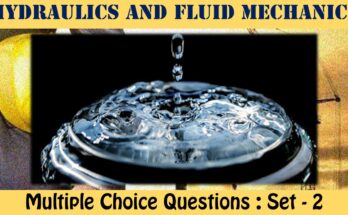MCQ Questions Civil Engineering Railway Engineering
The interviewer is almost as nervous as the candidate in most interviews. You might wonder if you look confident enough, if you will hire the right person, or if you are asking the right engineering interview questions. The last question is arguably the most crucial part to worry about when you’re interviewing candidates. Other topics on Civil Engineering Multiple Choice Questions can be accessed
MCQ Questions Civil Engineering Railway Engineering - Set - 1
Question 1:
Tensile strength of steel used in rails should not be less than
a) 450 MPa
b) 500 MPa
c) 700 MPa
d) 850 MPa
Correct Answer – (C)
Question 2 :
The cross-sectional area of 52 kg flat footed rail is
a) 6155 mm2
b) 6615 mm2
c) 7235 mm2
d) 7825 mm2
Correct Answer – (B)
Question 3 :
Largest percentage of material in the rail is in its
a) head
b) web
c) foot
d) head and foot both
Correct Answer – (A)
Question 4 :
The following tests are conducted for rails:
i) falling weight test
ii) tensile test
iii) hammer test
The compulsory tests are
a) only (i)
b) (i)and(ii)
c) (ii) and (iii)
d) (i) and (iii)
Correct Answer – (B)
Question 5 :
Two important constituents in the com-position of steel used for rail are
a) carbon and silicon
b) manganese and phosphorous
c) carbon and manganese
d) carbon and sulfur
Correct Answer – (C)
MCQ Questions Civil Engineering Railway Engineering
Question 6:
52 kg rails are mostly used in
a) Broad Gauge
b) Meter Gauge
c) Narrow Gauge
d) both (a) and (b)
Correct Answer – (A)
Question 7:
The purpose of providing fillet in a rail section is to
a) increase the lateral strength
b) increase the vertical stiffness
c) avoid the stress concentration
d) reduce the wear
Correct Answer – (C)
Question 8:
Largest dimension of a rail is its
a) height
b) foot width
c) head width
d) any of the above
Correct Answer – (A)
Question 9:
The standard length of rail for Broad Gauge and Meter Gauge are respectively
a) 12 m and 12 m
b) 12 m and 13 m
c) 13 m and 12 m
d) 13 m and 13 m
Correct Answer – (C)
Question 10:
The rail is designated by its
a) length
b) weight
c) cross-section
d) weight per unit length
Correct Answer – (D)
- NCERT Solutions Class 12 Mathematics RD Sharma Sets : Exercise 1.1
- NCERT Solutions Class 12 Mathematics RD Sharma Sets : Exercise 1.2
- NCERT Solutions Class 12 Mathematics RD Sharma Sets : Exercise 1.3
- NCERT Solutions Class 12 Mathematics RD Sharma Sets : Exercise 1.4
- NCERT Solutions Class 12 Mathematics RD Sharma Trigonometric Functions : Exercise – 5.1
- NCERT Solutions Class 12 Mathematics RD Sharma Trigonometric Functions : Exercise – 5.2
- NCERT Solutions Class 12 Mathematics RD Sharma Trigonometric Functions : Exercise – 5.3
- NCERT Solutions Class 12 Mathematics RD Sharma Quadratic Equations : Exercise – 14.1
- NCERT Solutions Class 12 Mathematics RD Sharma Quadratic Equations : Exercise – 14.2
- NCERT Solutions Class 12 Mathematics RD Sharma Linear Inequations : Exercise – 15.1
- NCERT Solutions Class 12 Mathematics RD Sharma Linear Inequations : Exercise – 15.2
- NCERT Solutions Class 12 Mathematics RD Sharma Linear Inequations : Exercise – 15.3
- NCERT Solutions Class 12 Mathematics RD Sharma Linear Inequations : Exercise – 15.4
- NCERT Solutions Class 12 Mathematics RD Sharma Linear Inequations : Exercise – 15.5
- NCERT Solutions Class 12 Mathematics RD Sharma Linear Inequations : Exercise – 15.6
Multiple Choice Questions for Competitive Exams
- Multiple Choice Questions Class 12 Chemistry The Solid State
Set -1 Set -2 Set -3 Set -4 Set -5 - MCQ Questions Class 12 Solutions With Answers
Set -1 Set -2 Set -3 Set -4 Set -5 - MCQ Questions Class 12 Electrochemistry With Answers
Set -1 Set -2 Set -3 Set -4 Set -5 - MCQ Questions Class 12 Chemical Kinetics With Answers
Set -1 Set -2 Set -3 Set -4 Set -5 - MCQ Questions Class 12 Surface Chemistry With Answers
Set -1 Set -2 Set -3 Set -4 Set -5 - MCQ Questions Class 12 General Principles and Processes of Isolation of Elements With Answers
Set -1 Set -2 Set -3 Set -4 Set -5




